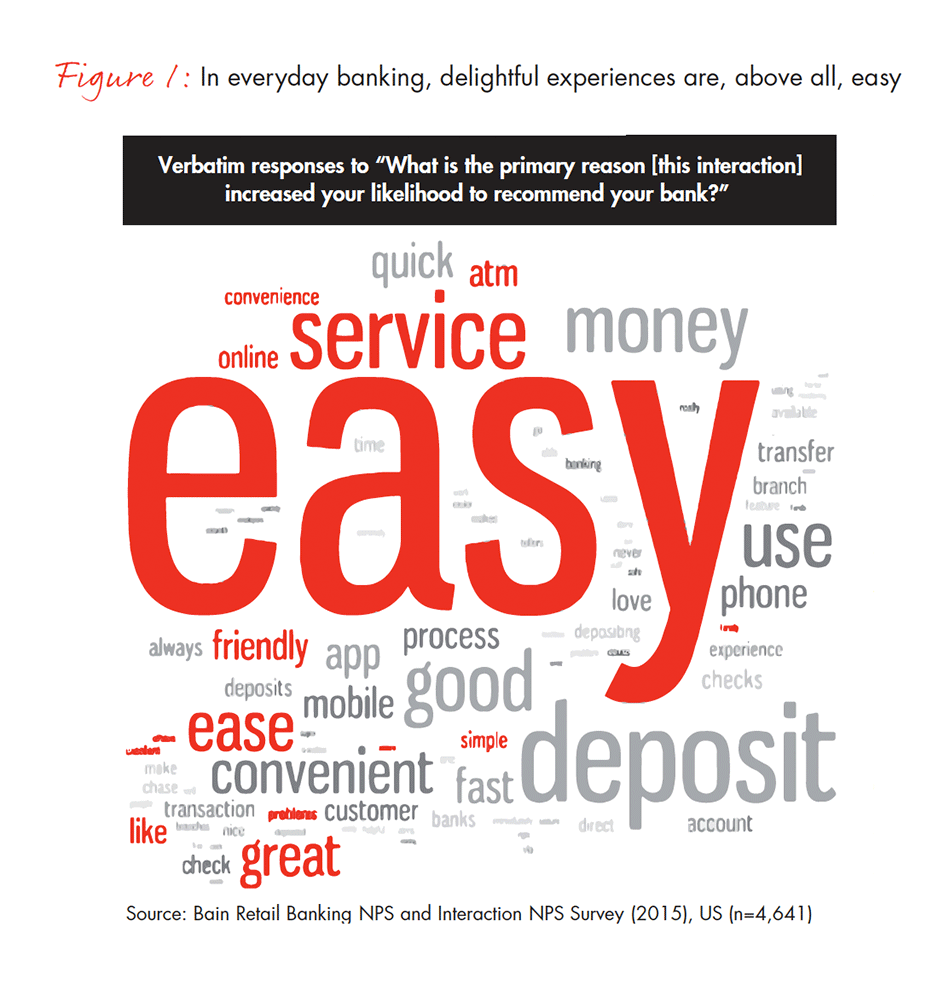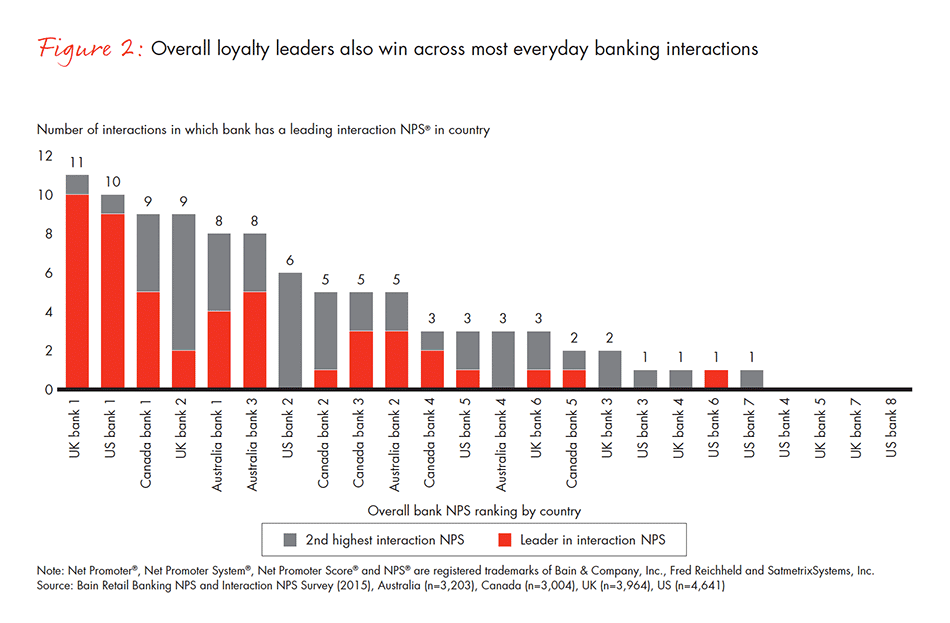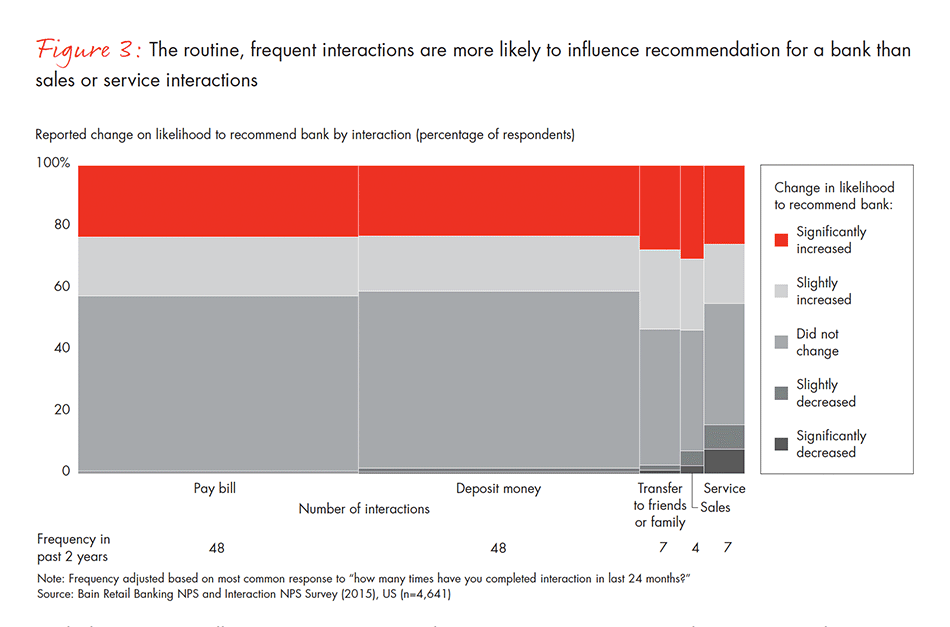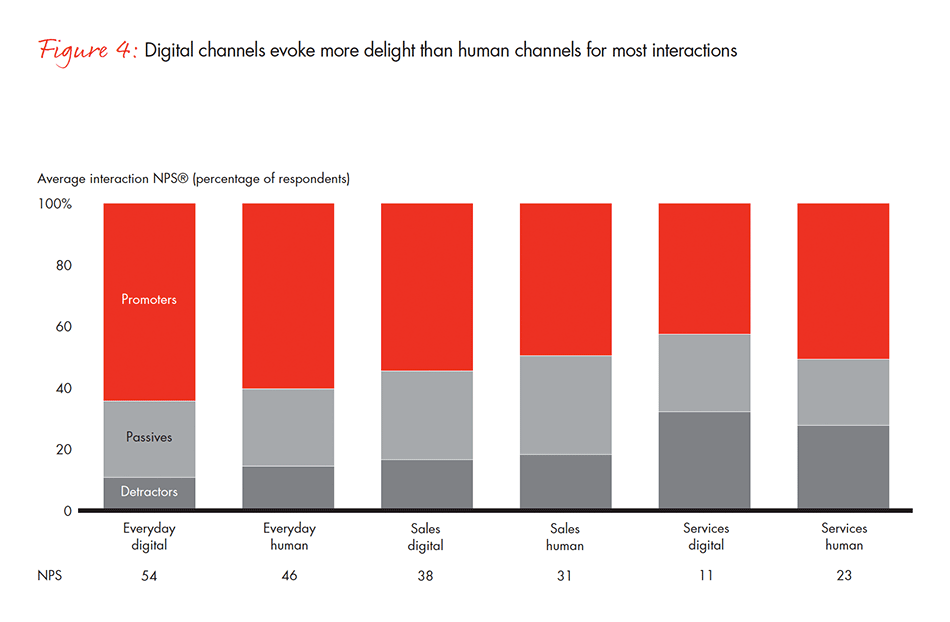Brief

The code that reveals the connection between consumers’ bank interactions and their loyalty to those banks has been cracked. It isn’t only big emotional episodes like fraud that matter to consumers, but also the mundane interactions that people deal with every day. For those interactions, the primacy of a branch that is conveniently near home or work, so important a decade ago, has been replaced by a new imperative: Just make it easy (see Figure 1).
Making it easy means, in part, making it mobile. The rub: Easy is hard for many banks.
Most retail banks recognize that earning customers’ loyalty improves the economics and competitive position of the business. Consumers who are promoters of a bank stay longer, buy more, refer their friends and colleagues and often cost less to serve than those who are detractors or, at best, passive.
But knowing which investments to make and where to focus management time and effort is not always straightforward. In the short term, should a bank upgrade its website, intensify training for call-center agents or overhaul its anti-fraud processes? With so many types of interaction between the bank and customers—especially customers who hold multiple products—how can managers select and sequence the most valuable investment areas?

In Search of Customers Who Love Their Bank
With banks facing increased competition from tech firms, our latest report examines how the banks can focus on what customers value most.
Consumers’ perceptions of their banking experiences point the way. Bain & Company recently surveyed 14,812 retail bank customers in Australia, Canada, the UK and the US. We asked customers to assign a Net Promoter Score® (a key measure of loyalty on a scale of 0 to 10) to their recent experiences with a dozen common banking interactions, from everyday transactions to more complex sales and service episodes. Our analysis of responses sheds light on how banks can determine which interactions affect loyalty among their customers and which merit immediate investment.
We find a clear correlation between a bank’s Net Promoter Score and the scores for individual interactions at the bank. For example, customers who are delighted by their recent bill-paying experiences tend to be advocates of the bank in general. By improving key individual interactions, the average bank across the four countries has the potential to raise its Net Promoter Score by 10 to 15 percentage points.

No single interaction stands out as the area for every bank to double down on improvements. In fact, the overall loyalty leaders in the four countries excel in most individual interactions (see Figure 2), and leaders in the US and the UK excel in all everyday transactions.

Certain interactions, though, do have a stronger effect than others on a bank’s Net Promoter Score. On average, routine interactions contribute more to the score than do sales and service interactions. Let’s parse the data to show why.
Of any single interaction, a sales interaction has the greatest influence on a bank’s loyalty score. For example, 68% of US customers who had a good experience opening a credit card, 74% who did for a new mortgage and 80% who did when opening a checking account said that they would be more likely to recommend their bank. The corresponding shares for customers who had a good experience with everyday transactions are lower, ranging from 51% to 57%. This difference makes intuitive sense, as getting a mortgage can be a complex, emotional episode that naturally generates delight with the bank when the interaction goes well. The opposite also applies: Sales and service interactions tend to go wrong more often than do routine interactions and cause greater damage to the customer relationship when they do so.
Sales and service interactions, however, occur much less frequently than routine interactions (see Figure 3). With frequency factored in, routine interactions have a greater cumulative effect: They contribute three to four times more than sales or service to the lift in a bank’s loyalty score across the four countries.

Analysis of consumer responses also shows that the greatest potential lift in loyalty comes from turning passive customers into promoters. Although each bank starts from a different point, in general 65% of the lift in a bank’s Net Promoter Score derives from creating promoters, and 35% derives from turning detractors into passive customers or even promoters. Banks tend to have more passive customers than detractors, so delighting passives creates a larger lift. This insight counters the belief among some bankers that leaning out processes and fixing the worst problems is all that’s needed to win over customers. Although those tasks might be a good place to start, earning loyalty takes far more than lean processes.
The right next moves for a bank depend on its customers’ current perceptions of individual interactions and of the bank overall. However, some general insights emerge from the survey analysis.
Mark Schofield, a partner in Bain's Financial Services practice, discusses how banks can improve the mobile experience to lower costs, boost sales and improve customer loyalty.
The battle is won or lost over routine interactions. While the effect of a single routine interaction is small, customers go through so many that the cumulative effect is large. For example, customers pay bills often: two to four times per month for the average respondent, depending on the country.
Banks that lead their competition or have a close second or third position on an interaction should focus on delighting customers by innovating on their already solid processes. For instance, they could improve their mobile app to be as close as possible to “one click,” allowing customers to check their account balance without needing to log in.

Customer Behavior and Loyalty in Retail Banking
Leading banks are taking a "mobile first" approach, shifting routine transactions from branches to digital self-service tools.
By contrast, banks with low relative scores and a large base of detractors in their everyday transactions should start by eliminating defects in those processes. For example, a login sequence that requires the user to scroll down to a new screen on a smartphone should be changed to a one-screen version.
Make it easy through mobile-first design. Everyday banking is still held hostage to traditional branch and contact-center channels. For most banks, we estimate that 60% to 70% of teller transactions are bad (because of errors or rework) or avoidable (because they would be quicker, easier and cheaper through digital channels). Such transactions should be migrated to digital channels.
Banks have two compelling reasons to migrate to digital: lower cost, and the fact that digital—especially mobile—interactions consistently create more customer delight for routine transactions than do traditional channels (see Figure 4). Simply installing a functional app or fixing what is broken in the current app is not sufficient to delight customers. An app must be reliable, convenient and easy to use if it is to shift volume away from branches. Now that most customers have used excellent apps from companies in other industries, they expect equally strong mobile features from their banks.

Migration also hinges on banks having a thoughtful process for changing behaviors of customers who are technology laggards. In the branch, for instance, employees can ask customers whether they would like to skip the line, then pull them aside to help them set up an online account and show them how to transact. The second or third visit might require further guidance, until the customer is comfortable with the technology.
Raise the bar in creating delightful sales and service interactions. Rare though they might be, sales and service interactions have a marked effect on loyalty. Here too, customers increasingly expect a seamless experience, whether digital, in person or on the phone.
Mobile apps gained popularity by making routine interactions easy to carry out anywhere, anytime. Now these apps are coming on strong in sales and service. Almost one-third of sales or service interactions in the past quarter occurred via mobile, Bain’s recent global consumer survey found.
Although digital sales and service transactions do not yet consistently delight more than digital routine transactions, that situation will likely improve over time as banks streamline their digital processes and build greater mobile sales and service capabilities. Mobile access also has more potential than the branch to delight customers in sales and service interactions, particularly when the mobile channel is fast and easy to use.
Employees still play essential roles in complex sales, service and advice settings, but the way in which they interact with customers is changing. Increasingly, these communications occur not in a branch but via mobile chat or video. As banks plug their frontline staff into the mobile hub, they can raise sales and service productivity by reaching more customers and reducing paperwork. Sales and service interactions that delight customers thus hinge on combining mobile-led design with empathetic, digitally skilled staff.

Just Make It Easy: Loyalty in Banking
Routine transactions have a greater overall effect on customer loyalty than complex sales and service transactions.
Connect the dots to improve entire episodes, not just individual interactions. Customers form their perceptions based on the whole sequence of interactions that they experience. For instance, when a hacker makes a fraudulent credit card purchase, a series of interactions follows: alerting the customer through various channels, verifying the customer’s identity, discussing the process of reversing the charge, counseling the customer on avoiding future fraud and issuing a new card. How the bank manages all those stages—the degree of speed, convenience and empathy that the customer experiences— shapes the customer’s perception of the bank.
At a minimum, banks need to measure the consumer experience from end to end. Moreover, delivery of a great experience requires closer collaboration among many departments in executing the operation across several channels and in acting on customer feedback to improve operations. Banks whose departments have historically operated “vertically” need to learn to run “horizontal” efforts that cut across the organization, just as customer episodes do.
Banks that want to redesign customers’ everyday interactions, or the rare but high-wire interactions, can analyze their customer feedback to determine the right sequence of investments. Devoting time and resources up front to extract insights from feedback enables a bank to understand where it falls short, where it has an opportunity to take the lead and how each type of interaction influences its customers’ loyalty, relative to competitors.
With those insights in hand, a bank can mobilize a cross-functional team of product owners, marketers, technologists, designers and, of course, compliance officers to co-create the highest priority episodes with consumers. The bank can then develop prototypes, test them quickly with customers, refine them and roll them out across the bank.
Those banks that master these episodes by taking a mobile-first design approach stand to delight more customers and improve their economics in the bargain.
Mark Schofield, Gerard du Toit and Maureen Burns are partners in Bain’s Financial Services practice. They are based, respectively, in Toronto, Boston and Boston.
Net Promoter®, Net Promoter System®, Net Promoter Score® and NPS® are registered trademarks of Bain & Company, Inc., Fred Reichheld and Satmetrix Systems, Inc.



